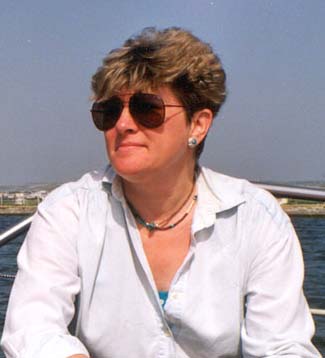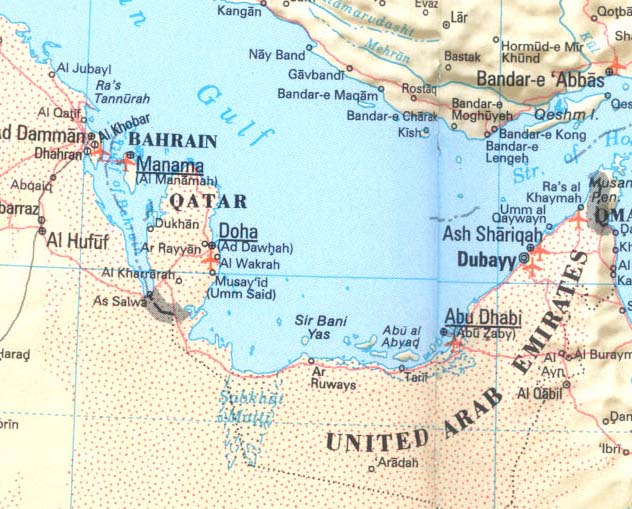

On our recent trip to visit forts on Qatar, we stopped at Al Ruwais, a fishing port on the north tip of Qatar and were struck by the lovely images of the amassed dhows seen here. I also show the interesting image of the ancient vessel tethered to a number of modern boats with outboard motors.
A bit of background on the dhow: it has two distinctive features, it's triangular or lateen sail, and it's stitched construction, that is sewing the hull boards together with fibers, cords or thongs. European vessels are named by their sail type, in the mid-east by their hull. Thus the naming of all vessels in the mid-East with triangular sails as dhows by Europeans loses some detail.
In addition to a couple photos taken at Al Ruwais on the northern tip of Qatar, I quote from an archaeological source and reference some web sites with a variety of information and pictures. Strongly recommended is taking a trip on one and that may well occur.
The Durable Dhow
by Tom Vosmer
For thousands of years Omanis have plied a sea-trading thoroughfare stretching north to Mesopotamia, east to India, and southwest to Africa. Taking advantage of seasonal winds, they sailed to foreign ports during the winter, returning home in the summer. In addition, the Arabs developed a highly effective triangular sail, called a lateen, and the kamal, a navigating device that enabled them to determine latitude by gauging the height of the Pole Star above the horizon. They eventually established colonies along the African coast, in Mogadishu, Mombasa, Lamu, and Zanzibar, where they operated lucrative clove plantations.
In addition to a couple photos taken at Al Ruwais on the northern tip of Qatar, I quote from an archaeological source and reference some web sites with a variety of information and pictures. Strongly recommended is taking a trip on one and that may well occur.
The Durable Dhow
by Tom Vosmer
For thousands of years Omanis have plied a sea-trading thoroughfare stretching north to Mesopotamia, east to India, and southwest to Africa. Taking advantage of seasonal winds, they sailed to foreign ports during the winter, returning home in the summer. In addition, the Arabs developed a highly effective triangular sail, called a lateen, and the kamal, a navigating device that enabled them to determine latitude by gauging the height of the Pole Star above the horizon. They eventually established colonies along the African coast, in Mogadishu, Mombasa, Lamu, and Zanzibar, where they operated lucrative clove plantations.
Indigenous to the coasts of the Arabian peninsula, India, and East Africa, the earliest dhows were shell built--simple dugouts with teak planks sewn to their sides to form a hull. Gradually, larger vessels evolved, employing a keel to which planking was sewn. Shell-built construction differed from the European frame-first method, in which planking was attached to ribbing. Shell-building allowed shipwrights to create a vessel one plank at a time. If changes were requested, one could simply alter the shape of a plank or its angle of attachment.
Most dhows are known by names referring to their hull shape. The ghanjah is a large vessel with curved stem (the boat's foremost timber) and a sloping, ornately carved transom, the ship's flat back end. The baghlah, no longer built, was the traditional deep-sea dhow; it had a transom with five windows and a poop deck reminiscent of European galleons. Double-ended dhows, like the boom, have both stem and stern posts. The battil, also no longer built, featured long stems topped by large, club-shaped stem heads and stern posts decorated with cowrie shells and leather. The badan was a smaller vessel requiring a shallow draught.
Without archaeological evidence--no ancient wreck of a vessel indigenous to the western Indian Ocean has ever been found--it is difficult to discern foreign influences on dhow design. We do know that iron nail fastenings began to supplant sewn planks after Portuguese and other European ships entered the region in the early sixtennth century. Many feel the majestic baghlahs and ghanjahs, with their ornate transom decoration and grand size, were the apogee of dhow building. In terms of pure design, however, the smaller, double-ended battils and badans were the finest expression of the tradition.
http://www.archaeology.org/9705/abstracts/dhow.htmlsee also
The Traditional Dhow
http://www.omanet.om/english/culture/boats.asp?cat=cult
Dhows of the Arabian Gulf – a brief introduction
http://www.agmgifts.co.uk/dhows.html
The History and Construction of the Dhow
http://www.nabataea.net/ships.html










.jpg)








